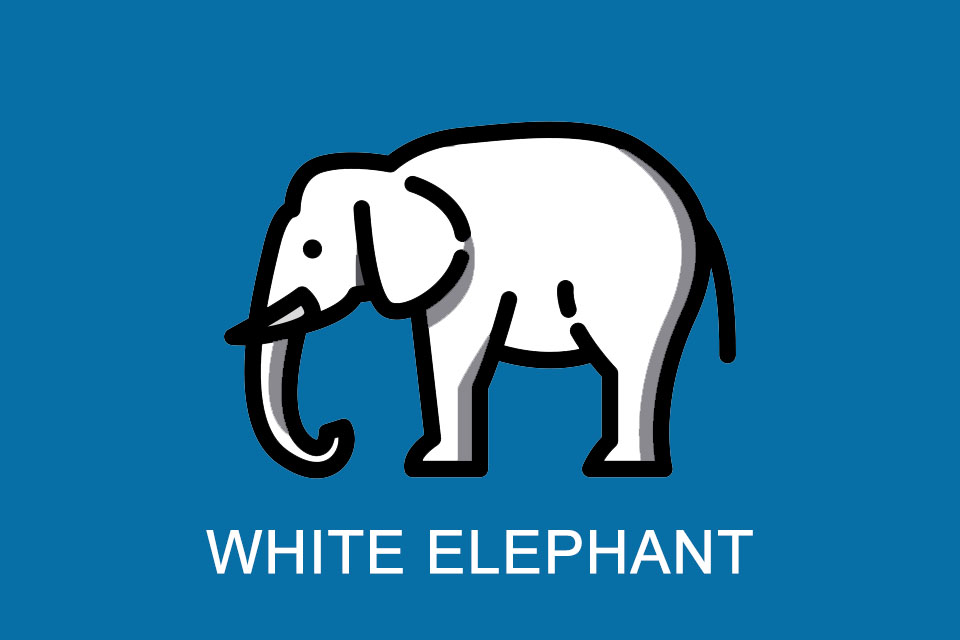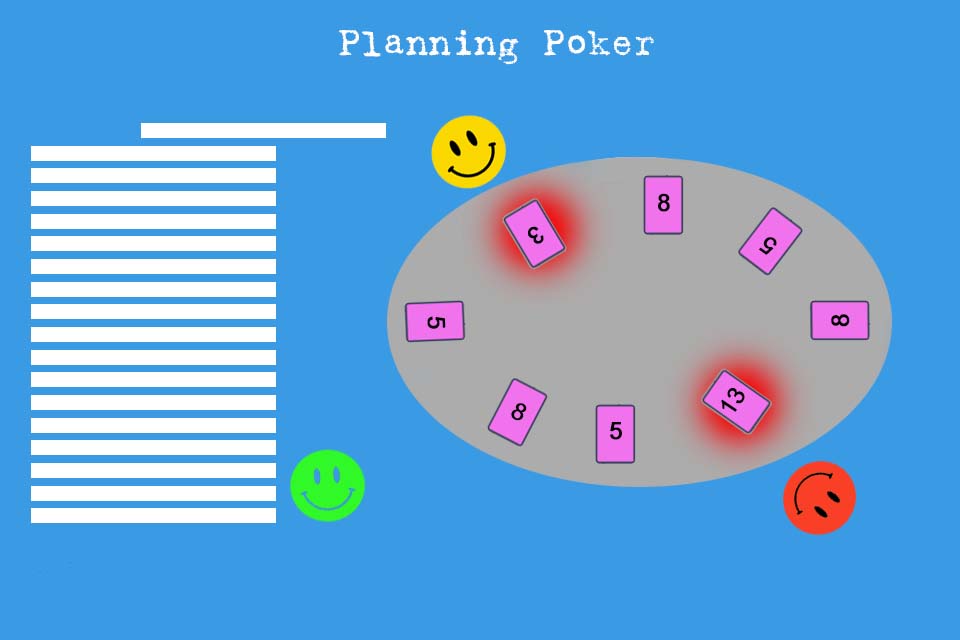What is a White Elephant?
Table of Contents: Definition – Principle – Technique – Estimation method – Gift exchange – Notes
White elephant – the big thing that nobody wants
The term white elephant often causes confusion because it is used in different contexts: as an economic metaphor, as a workshop technique, as an agile estimation method or as a game of chance. What all these usages have in common is the original image of a valuable but burdensome gift.
The term originally comes from Southeast Asia, particularly from Thailand. White elephants were considered sacred there and were not allowed to be used for work. Keeping them was extremely expensive, but their owner could neither use nor reject them. [1] Such an elephant was therefore a prestigious but costly and ultimately burdensome gift. From this tradition, the term developed as a metaphor for oversized, inefficient or unnecessary investments.
Applied to today’s situations in companies, organisations or teams, the term white elephant describes things that are visible, expensive or time-consuming – but hardly bring any real benefit. Often they are continued out of habit, for political or emotional reasons, or because of investments that have already been made. This is precisely where the various forms of the white elephant concept come into play: as a principle, as a technique for reflection, as a method for prioritisation or cost estimation, or as a symbol in playful contexts.
The white elephant principle
The white elephant principle describes a recurring pattern: it is about investments – whether in the form of projects, products, systems or infrastructures – that incur high costs over a long period of time but provide little or no measurable benefit. Nevertheless, they are continued. The reason for this often lies not in their factual logic, but in emotional, political or organisational constraints.
What makes this phenomenon a principle is its structural recognisability: the mechanism repeats itself in many contexts – across industries, organisations and levels. Typically, the initial decision (e.g. to start a major project) is no longer questioned later because too much money, time or reputation has already been invested. This clinging to a project for fear of losing face or because of the ‘sunk cost fallacy’ is a central element of the white elephant principle.
Such projects are often kept alive for years, even though it would make more sense to abandon them or radically restructure them. The symbolism, the effort involved or the political context make backing down seemingly impossible.
Typical characteristics:
- high investment and operating costs
- Insignificant or no longer traceable benefits
- emotional or political hurdles to terminating the project
- symbolic value that makes critical discussion difficult
Examples:
- empty airports or train stations
- IT systems that are rarely used but require extensive maintenance
- organisational projects whose goals are no longer relevant
The white elephant principle sensitises you to such situations at an early stage and helps you develop the courage to part with the superfluous – even if it is uncomfortable.
The white elephant technique
The white elephant technique is a creative team-building method for making unspoken issues, redundant processes or ignored burdens visible. In workshops or retrospectives, team members can symbolically name ‘white elephants’ – aspects that are in the room but not openly addressed. The technique promotes open communication and mutual understanding and helps to uncover blind spots in everyday work.
It is particularly suitable when there is noticeable tension in a team but it is difficult to identify the specific causes. The symbolism of the ‘white elephant’ means that even sensitive topics can be addressed in a creative and indirect way.
Procedure:
- The moderator explains the image of the white elephant and its meaning. The aim is to make burdensome, unspoken or redundant issues visible together.
- Each team member thinks quietly to themselves about what a ‘white elephant’ is for them in the team, project or process.
- The participants write their points on cards or digital post-its (e.g. with an elephant symbol).
- The cards are collected anonymously and made visible to everyone (e.g. on a board, flipchart or digital whiteboard).
- Similar topics are grouped together to identify patterns.
- The group selects one to three central elephants and discusses causes, effects and possibilities for change.
- Together they decide which first steps to improvement should be taken.
Since the white elephant technique potentially touches on sensitive topics, good facilitation is particularly important. The facilitator should create an atmosphere of trust in which all participants feel safe to speak honestly. This also includes clearly announcing the method and emphasising that participation is voluntary. It helps to lead by example with small examples and to consciously contribute one’s own observations in order to exemplify openness.
It is important that all voices are heard – even the quiet ones. The moderator should ensure balance without creating pressure. At the same time, it makes sense to keep expectations realistic: not every ‘elephant’ has to be resolved immediately. Often it is enough to make it visible and to set the first impulses for change. The technique thrives on empathy, clarity and an appreciative approach to the issues raised.
White elephant as an estimation method
The white elephant sizing game is an agile estimation method that helps teams quickly and collaboratively assess the relative effort of user stories. The playful nature of the game promotes interaction, a change of perspective and a shared understanding of the scope of the tasks at hand.
The estimation method is about identifying user stories that appear particularly large, complex or unclear – the elephants in the backlog, so to speak. The method makes these items visible and invites teams to estimate effort together before these projects develop into real burdens unnoticed. [2] Some teams even expand the game to include humorous categories such as dinosaur or Godzilla to make the oversized nature of some items particularly clear.
Preparation:
- A whiteboard or a large sheet of paper is divided into columns. Unlike classic T-shirt sizes, many teams deliberately use symbolic categories to illustrate the scale and complexity of tasks – such as: mouse, dog, horse, elephant or even Godzilla. This makes it immediately clear which tasks are out of the ordinary.
- All the user stories to be estimated are written on individual cards, ideally with a short description for better classification.
You will also need: a timer to measure time, as well as adhesive materials or digital post-its.
How to play:
- The team stands in front of the board. The cards with the user stories are placed face down in a stack.
- The timer is started. The first team member draws a card, reads it aloud and has three options: the card is placed in the column that corresponds to the estimated effort. An already placed card is moved to another column, along with a brief explanation. And if no action seems necessary, it is simply passed on.
Then it is the next team member’s turn. The process is repeated until all cards have been placed and no further repositioning is necessary.
Afterwards, the team reflects on the assignment together. Open questions or discrepancies are clarified, and if necessary, product owners or stakeholders can be consulted for their assessment. The goal is to achieve an assessment of the effort that is as consistent and realistic as possible.
The white elephants sizing game is particularly suitable for refinement sessions with many items and limited time, as it combines interaction and focus while providing a solid foundation for further discussions.
The white elephant gift exchange
The so-called white elephant gift exchange is a popular gift-giving tradition that takes place primarily in private circles – for example at Christmas parties or social gatherings among friends. Each person brings a wrapped gift that is ideally curious, useless or particularly funny. The gifts are drawn, swapped or ‘stolen’ one after the other – with the aim of having fun and getting the most bizarre items possible.
Although the game refers to the same origin as the white Elephant principle, it has no connection to organisations or companies in terms of content. It is not about strategic reflection or project evaluation, but about entertainment and surprise. The term ‘White Elephant’ is used here purely for the purpose of play, to highlight unexpected or absurd gifts.
Impulse to discuss:
Does your organisation also have white elephants? And if so, why don’t you talk about them?
Notes:
[1] The historical background of the white elephant
[2] If an elephant has been identified in the course of the estimation, the Slicing the Elephant method could be used.
The term ‘white elephant’ is multi-layered and mutable, but its core meaning remains the same: it refers to things that are more of a burden than a benefit, but continue to exist nonetheless. Whether as a principle, method or technique – consciously dealing with white elephants helps to conserve resources, create clarity and make bolder decisions.
If you like the article or would like to discuss it, please feel free to share it in your network. And if you have any comments, please do not hesitate to send us a message.
And here you will find additional information from our Smartpedia section:



